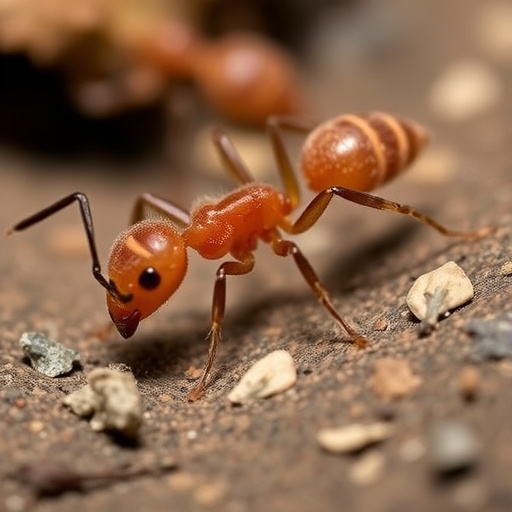A groundbreaking study from the University of Toronto Scarborough has unveiled a troubling dimension to the ecological impacts of climate change: the potential for indoor-dwelling ants, previously confined to sheltered environments in cooler climates, to invade outdoor habitats as global temperatures rise. This research, featured in the esteemed journal Diversity and Distributions, sheds new light on the complex relationship between warming climates and biological invasions, particularly emphasizing the underestimated role of indoor environments as stepping stones for ant species invasions.
The study meticulously analyzed comprehensive global datasets encompassing 323 non-native ant species distributed across 477 geographically distinct regions. Employing robust climate models, researchers demonstrated that an anticipated increase of 2ºC to 4ºC due to global warming could significantly enhance the ability of these ants, historically restricted to indoor refuges, to establish outdoor populations. The phenomenon is especially pronounced in the colder areas of the Northern Hemisphere, where previously inhospitable climates have protected native ecosystems from these invasive species.
Traditionally, invasive species research has concentrated almost exclusively on outdoor ecosystem dynamics. However, this study highlights the pivotal sanctuary role that anthropogenic indoor environments—such as residential homes, commercial buildings, and greenhouses—play in harboring these non-native ant populations. These indoor habitats create artificially stable microclimates with warmer, predator-free conditions, facilitating survival and reproduction of species that would otherwise perish in colder outdoor climates.
According to Toby Tsang, the principal investigator and postdoctoral fellow in the Department of Biological Sciences at U of T Scarborough, the gradual warming of the planet effectively transforms these habitats from isolated sanctuaries into strategic launchpads for expansion. Indoor environments buffer the ants against harsh climatic pressures and predation, enabling populations to build up density and genetic diversity over time. Consequently, once temperature thresholds outside are breached, these ants possess the competitive advantage and resilience to migrate and colonize natural ecosystems.
The mode of introduction for these indoor ant populations is often inadvertent, facilitated by global trade and human manufacture-related activities. Ants frequently hitchhike in cargo shipments, potted plants, soil, wooden pallets, and the myriad of cracks and crevices found in shipping containers and consumer goods packaging. This unintentional dissemination pathway allows them to leapfrog natural geographic barriers, arriving in regions far beyond their indigenous ranges, ready to establish indoor footholds under microclimatic insulation.
Indoor habitats not only protect these invaders from climatic stressors but also shield them from biological control agents present outdoors. The absence of natural predators, competitors, and parasites in these environments drastically reduces mortality rates. Coupled with typically abundant anthropogenic food resources, including household waste and plant nectars within greenhouses, the ants find themselves in remarkably favorable environments that promote rapid population growth and colony expansion.
One particularly alarming example spotlighted in the study is Wasmannia auropunctata, commonly known as the electric ant or little fire ant. This species, native to Central and South America, is notorious for its intensely painful sting relative to its small size, as well as its aggressive territorial behavior. Already globally invasive in five continents, the electric ant maintains indoor populations inside Canadian greenhouses while posing a direct threat to native species and ecosystems if outdoor environments warm sufficiently to accommodate its expansion.
The electric ant’s ecological and agricultural impacts are profound. It outcompetes indigenous ant species, disrupting established community dynamics and food webs. Furthermore, it preys upon a wide array of insects and small animals, upsetting ecological balance. In agricultural settings, the species is known to defend pest insects like aphids in exchange for honeydew—a sugary secretion—thereby exacerbating crop damage. Additionally, this ant is a known health hazard, capable of delivering stings that can cause severe pain, allergic reactions, and, in extreme cases, even blindness.
Despite the evident risks posed by these indoor-invading ants, current surveillance and invasive species monitoring programs often neglect these indoor populations. Tsang emphasizes that the invisibility of indoor ant colonies to traditional field surveys results in significant gaps in early detection and management strategies. The clandestine nature of these ants demands specialized monitoring approaches that incorporate urban and controlled environment sampling to comprehensively track invasion frontiers.
The study also identifies other potentially devastating species such as the Argentine ant alongside Wasmannia auropunctata, both possessing remarkable invasive capabilities. These species demonstrate not only ecological dominance by outcompeting native ants and other invertebrates but also have implications for human health, given their capacity to cause painful stings and allergic reactions. Their ecological plasticity and resilience make controlling their spread increasingly urgent amidst changing climatic regimes.
As global temperatures continue to rise, the interface between indoor refuges and outdoor ecosystems will become a critical battleground in the fight against invasive species proliferation. The researchers advocate for a paradigm shift in invasion biology, expanding focus beyond natural and outdoor ecosystems to include anthropogenically-modified microhabitats. Integrating climate modeling with detailed indoor ecological studies will be essential to predict invasion trajectories accurately and implement timely interventions.
The implications of this research resonate globally, calling for policymakers, ecologists, and agricultural managers to reevaluate existing biosecurity frameworks to incorporate the hidden threat posed by indoor ant populations. Climate change adaptation strategies must therefore encompass surveillance systems capable of detecting and responding to ant invasions at the indoor-outdoor nexus, particularly in regions currently considered too cold for such invasions.
This pioneering study underscores the complex and multifaceted nature of climate change impacts on biodiversity and ecosystem stability. It challenges conventional assumptions regarding the spatial limits of invasive species and reveals the profound consequences of anthropogenic environmental modifications combined with global warming. Ultimately, the findings illuminate an urgent need for interdisciplinary approaches to anticipate and mitigate the silent spread of invasive ants from indoor sanctuaries into the world beyond.
Subject of Research: Animals
Article Title: Climate Change Can Exacerbate Ant Invasion Impacts by Unleashing Indoor Populations Into Outdoor Environments
News Publication Date: 3-Jul-2025
Web References:
https://onlinelibrary.wiley.com/doi/10.1111/ddi.70041
http://dx.doi.org/10.1111/ddi.70041
Keywords:
Invasive species, Climate change effects, Environmental issues, Ants, Insects, Invasive animals, Climate change adaptation




